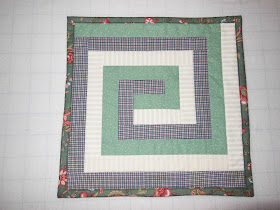This design is also known as a Spiral Log Cabin.
 |
| This wall quilt is 20 inches square |
Selecting fabrics for a quilt is the first and one of the most enjoyable steps in designing and making a quilt. All fabrics were fat quarters that were picked from an existing stash.
 |
| Dots, checks and stripes |
Using my colored drawing, I picked the focus fabric. Because this focus fabric would have to serve as the last log, (22" long) and because fat quarters are cut 18" by 22" long, I decided to cut the strips 2" wide and also folded each fat quarter in half along the 22" edge, prior to cutting.
 |
| Colored drawing |
I then created a strawman for the sewing sequence and penciled in the color replacements at the bottom of the drawing, along with the cutting measurements for each log. I next calculated the number of strips I would need from each fabric and wrote that at the top of the strawman.
 |
| Strawman of sewing sequence |
Strips were cut 2" wide for a finished size of 1-1/2" logs.
 |
| 2" wide strips |
Following the sewing sequence on the strawman, the first two logs at the center of the block were sewn together, the length trimmed to equal the width and pressed away from the center (checked fabric in this case) of the block.
 |
| 1st 4 logs are sewn |
Instead of cutting each log to the required length, the strip method of sewing the logs together saved a lot of time. The new strip is placed right side up, the sewn block placed on the strip face down on it (making sure the new log is sewn on the correct edge). This strip piecing method saves a great deal of time if several log cabin blocks have to be made.
 |
| Sewn block is placed on strip |
What I noticed was that, beginning with the 5th log, the log that comprised the same fabric as the new strip always appeared in the top right hand corner.
 |
| Block placement |
To avoid skewing the block, the strip is placed a tiny bit above the block. The sewn block is then squared up by cutting away the excess at the top and bottom of the block.
 |
| Cut excess fabric at top of sewn block |
 |
| Cut excess fabric at bottom of sewn block |
All sewn seams are pressed away from the center of the block.
 |
| Press all seams towards newest log |
The rhythm therefore is to sew, trim and press. With the quilt top done, it was time to decide on the binding fabric. Because the block is so graphic and angular, I decided on a floral fabric for the binding.
 |
| Floral binding fabric |
The quilt top was layered with batting and backing fabric and pinned in place. The batting and backing fabric were then cut 1/2" larger than the quilt top, so that the binding finished at 3/4".
 |
| Quilt top layered and pinned |
The top was quilted in the ditch (within the seams), the binding was sewn on and the quilt was done!
 |
| Quilted and bound |
Here is the back of the quilt.
 |
| Back of quilt |
The quilt can be used as a table topper or as a wall hanging.
 |
| Table topper |
I hope you enjoy making this log cabin quilt as much as I did.
Cheers!

















Great post, Chumkie. I'd love to try it too. That strip piecing method looks so easy..:)
ReplyDeleteIt is easy! Hope you enjoy trying it.
Delete